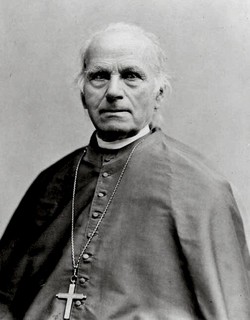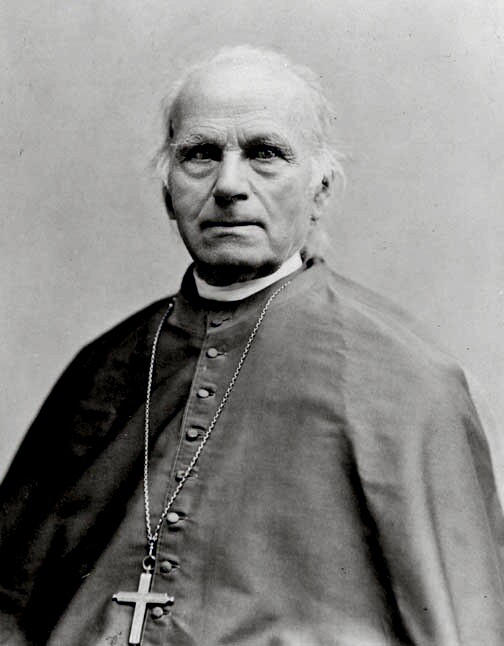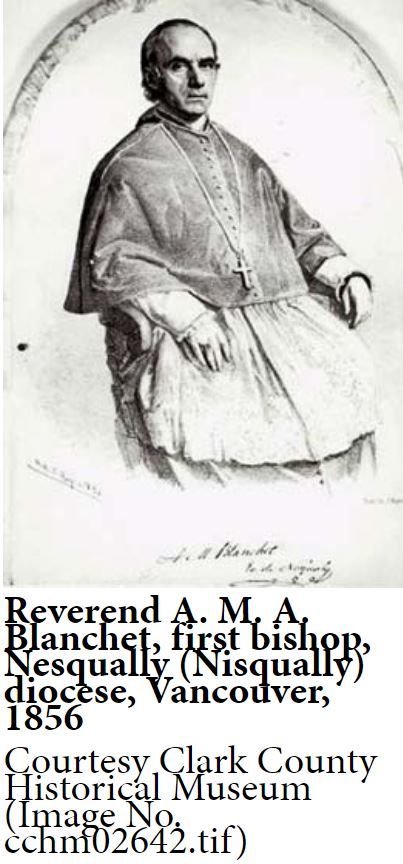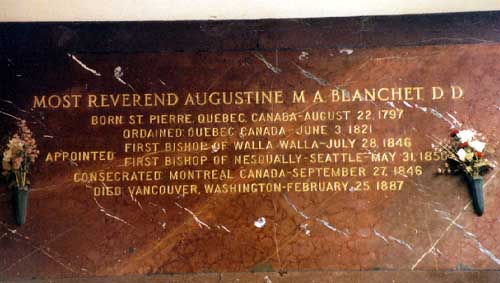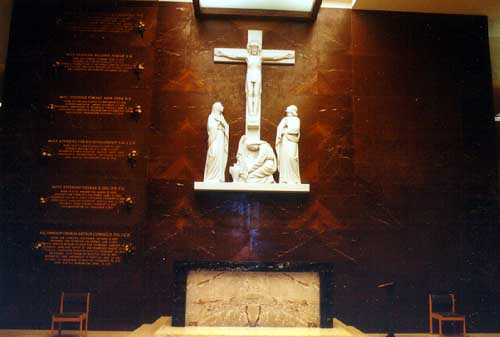____________________________________________________________________
Bishop Augustin Blanchet Dedicates Washington's Original St. James Cathedral at Fort Vancouver on January 23, 1851
On January 23, 1851, Bishop Augustin Magloire Alexandre (A. M. A.) Blanchet (1797-1887) consecrates as a Catholic cathedral a rustic missionary church on land adjacent to the Hudson's Bay Company's Fort Vancouver headquarters. The wooden structure is built and paid for by Hudson's Bay at the request of Francis N. Blanchet (1795-1883), Father A. M. A. Blanchet's brother and the first Archbishop of the see, or diocese, of Oregon City. After serving as a simple parish church for the Roman Catholic residents of Fort Vancouver and the surrounding area, its status is upgraded to the cathedral when the Nisqually diocese is created and A. M. A. Blanchet is appointed bishop. It will serve as the seat of the diocese until 1885 when a much grander St. James Cathedral is completed in the City of Vancouver.
The new cathedral will be the headquarters of the church in Western Washington for more than two decades, then will revert to a parish church when Bishop Edward J. O'Dea (1856-1932) moves the diocese to Seattle and builds a new St. James Cathedral.
Answering the Call
In the 1830s, the Hudson's Bay Company employed several hundred people west of the Rockies, many of them Catholic French Canadians. The need for a Catholic ministry was keenly felt, and several petitions were delivered to the Bishop of Montreal asking that clergy be sent west. In 1837, Father Francis N. Blanchet and Father Modeste Demers were dispatched from Montreal with a westward-bound Hudson's Bay expedition, arriving at Fort Vancouver on November 24, 1838. Thus began the Quebec Mission to Oregon Country, a mission that eventually led to the establishment in Vancouver of the first Catholic cathedral north of the Columbia River.
For four years the two priests alone carried the church's mission to the entire region, traveling from settlement to settlement, ministering to the faithful, and trying to convert tribal peoples. In 1842, two more Canadian priests, Fathers Antoine Langlois and Z. Bolduc came to their assistance. Two years after that, Father Pierre-Jean De Smet (1801-1873) arrived with four other Jesuit priests, three lay brothers, and six nuns. The core of a substantial clerical presence was now in place; what was needed next was an appropriate house of worship.
A Church of One's Own
For several years after Fathers Blanchet and Demers arrived, Catholic services at Fort Vancouver were held in buildings within the fort's stockade, including a storehouse that was used by both Catholics and Protestants. This arrangement pleased neither group, and by 1845 Father Blanchet had obtained the company's permission to build a new church on donated land north and west of the stockade and a promise that the company would pay for the construction.
The new building was completed during the winter of 1845-1846 and dedicated as St. James Church on May 30, 1846. It was an unadorned structure measuring 83 feet long by 36 feet wide and 20 feet high and could accommodate about 500 people. A drawing from 1866 indicates that a steeple later was added to the front of the church, giving it a somewhat grander appearance. It was built to be a simple parish church, but within just a few years this modest structure would become Washington's first St. James Cathedral and the seat of a diocese that encompassed all of Western Washington.
Three New Sees, Two Father Blanchets
Shortly after St. James Church was dedicated, Pope Gregory XVI created an ecclesiastical province in the Pacific Northwest, dividing the area into three sees, or dioceses, and appointing new bishops to preside over them. On July 24, 1846, Father Francis Blanchet was named Archbishop of Oregon City (the see was later moved to Portland), and four days later, Father Demers was made Bishop of Vancouver Island.
The third see was headquartered in Walla Walla, and on September 27, 1846, the Pope appointed Francis Blanchet's brother, Father Augustin Magloire Alexandre (A. M. A.) Blanchet, as bishop. A. M. A. Blanchet traveled from Montreal to his new post, reaching Walla Walla on October 4, 1847.
Eight weeks later, on November 29, 1847, Cayuse tribal members killed 13 whites at a nearby Protestant mission in what came to be known as the Whitman Massacre. It clearly was not a good time to be a Christian missionary east of the Cascade Mountains.
To Safety
The church maintained a presence in Walla Walla for nearly three tense years after the attack on the Whitman mission, but abandoned the seat of the diocese in 1850, transferring its administration to Oregon City. On May 31, 1850, Rome divided up the Oregon City see and established another new diocese. The papal decree stated:
"And so with certain knowledge and our mature deliberation, and from the fullness of the Apostolic power, we separate the aforementioned region of Nesqually from the Archdiocese of Oregon City, and we divide it up and we erect it into an Episcopal Church and establish that it be ruled and directed by its own Bishop …" ("1850: Diocese of Nisqually Established")
The Nisqually diocese's "own Bishop" was to be A. M. A. Blanchet, who found himself with neither a congregation nor a church after being forced to leave the dangerous environs of Walla Walla.
The First St. James Cathedral
The natural seat for the new Nisqually Diocese was Fort Vancouver, which not only had a church building in place but also offered the protection of the Hudson's Bay Company and a substantial population of Roman Catholics. On October 27, 1850, Bishop A. M. A. Blanchet officially announced the new diocese and on January 23, 1851, dedicated the modest St. James Church as its cathedral.
Over the next few years, the population of the lands north of the Columbia River soared. Congress created the Territory of Washington in 1853, and St. James Cathedral was now the seat of a diocese that stretched from the Columbia north to the 49th parallel. As the population grew, Bishop Blanchet asked the Bishop of Montreal for more assistance.
On December 8, 1856, five Sisters of Providence nuns arrived at the fort, led by Sister Joseph (1823-1902), later Mother Joseph. They quickly established a boarding school, an orphanage, and St. Joseph's Hospital. By 1864, 31 Providence Sisters, seven diocesan priests, five Jesuit priests, and two Oblate missionaries were serving a Catholic population of about 8,000 within the Nisqually Diocese.
The Second St. James Cathedral
Bishop A. M. A. Blanchet retired as Bishop of Nisqually in 1879, with a parting prayer that those who followed him would "have the pleasure of seeing mature the good seed which has been scattered in this garden of God during the past forty years" ("Right Reverend A. M. A. Blanchet, D.D,"). He needn't have worried. His successor, Bishop Aegidius Junger (1833-1895), went on to establish parishes in Aberdeen, Bellingham, Chehalis, Everett, Puyallup, Seattle, Snohomish, and Tacoma. He also resolved to build a new cathedral in what was now the City of Vancouver, a cathedral worthy of a flourishing and far-flung diocese.
historylink.org
By John J. Caldbick Posted 8/29/2009
The Free Encyclopedia of Washington State History
transcribed by Kerry
____________________________________________________________________
Bishop Augustin Blanchet Dedicates Washington's Original St. James Cathedral at Fort Vancouver on January 23, 1851
On January 23, 1851, Bishop Augustin Magloire Alexandre (A. M. A.) Blanchet (1797-1887) consecrates as a Catholic cathedral a rustic missionary church on land adjacent to the Hudson's Bay Company's Fort Vancouver headquarters. The wooden structure is built and paid for by Hudson's Bay at the request of Francis N. Blanchet (1795-1883), Father A. M. A. Blanchet's brother and the first Archbishop of the see, or diocese, of Oregon City. After serving as a simple parish church for the Roman Catholic residents of Fort Vancouver and the surrounding area, its status is upgraded to the cathedral when the Nisqually diocese is created and A. M. A. Blanchet is appointed bishop. It will serve as the seat of the diocese until 1885 when a much grander St. James Cathedral is completed in the City of Vancouver.
The new cathedral will be the headquarters of the church in Western Washington for more than two decades, then will revert to a parish church when Bishop Edward J. O'Dea (1856-1932) moves the diocese to Seattle and builds a new St. James Cathedral.
Answering the Call
In the 1830s, the Hudson's Bay Company employed several hundred people west of the Rockies, many of them Catholic French Canadians. The need for a Catholic ministry was keenly felt, and several petitions were delivered to the Bishop of Montreal asking that clergy be sent west. In 1837, Father Francis N. Blanchet and Father Modeste Demers were dispatched from Montreal with a westward-bound Hudson's Bay expedition, arriving at Fort Vancouver on November 24, 1838. Thus began the Quebec Mission to Oregon Country, a mission that eventually led to the establishment in Vancouver of the first Catholic cathedral north of the Columbia River.
For four years the two priests alone carried the church's mission to the entire region, traveling from settlement to settlement, ministering to the faithful, and trying to convert tribal peoples. In 1842, two more Canadian priests, Fathers Antoine Langlois and Z. Bolduc came to their assistance. Two years after that, Father Pierre-Jean De Smet (1801-1873) arrived with four other Jesuit priests, three lay brothers, and six nuns. The core of a substantial clerical presence was now in place; what was needed next was an appropriate house of worship.
A Church of One's Own
For several years after Fathers Blanchet and Demers arrived, Catholic services at Fort Vancouver were held in buildings within the fort's stockade, including a storehouse that was used by both Catholics and Protestants. This arrangement pleased neither group, and by 1845 Father Blanchet had obtained the company's permission to build a new church on donated land north and west of the stockade and a promise that the company would pay for the construction.
The new building was completed during the winter of 1845-1846 and dedicated as St. James Church on May 30, 1846. It was an unadorned structure measuring 83 feet long by 36 feet wide and 20 feet high and could accommodate about 500 people. A drawing from 1866 indicates that a steeple later was added to the front of the church, giving it a somewhat grander appearance. It was built to be a simple parish church, but within just a few years this modest structure would become Washington's first St. James Cathedral and the seat of a diocese that encompassed all of Western Washington.
Three New Sees, Two Father Blanchets
Shortly after St. James Church was dedicated, Pope Gregory XVI created an ecclesiastical province in the Pacific Northwest, dividing the area into three sees, or dioceses, and appointing new bishops to preside over them. On July 24, 1846, Father Francis Blanchet was named Archbishop of Oregon City (the see was later moved to Portland), and four days later, Father Demers was made Bishop of Vancouver Island.
The third see was headquartered in Walla Walla, and on September 27, 1846, the Pope appointed Francis Blanchet's brother, Father Augustin Magloire Alexandre (A. M. A.) Blanchet, as bishop. A. M. A. Blanchet traveled from Montreal to his new post, reaching Walla Walla on October 4, 1847.
Eight weeks later, on November 29, 1847, Cayuse tribal members killed 13 whites at a nearby Protestant mission in what came to be known as the Whitman Massacre. It clearly was not a good time to be a Christian missionary east of the Cascade Mountains.
To Safety
The church maintained a presence in Walla Walla for nearly three tense years after the attack on the Whitman mission, but abandoned the seat of the diocese in 1850, transferring its administration to Oregon City. On May 31, 1850, Rome divided up the Oregon City see and established another new diocese. The papal decree stated:
"And so with certain knowledge and our mature deliberation, and from the fullness of the Apostolic power, we separate the aforementioned region of Nesqually from the Archdiocese of Oregon City, and we divide it up and we erect it into an Episcopal Church and establish that it be ruled and directed by its own Bishop …" ("1850: Diocese of Nisqually Established")
The Nisqually diocese's "own Bishop" was to be A. M. A. Blanchet, who found himself with neither a congregation nor a church after being forced to leave the dangerous environs of Walla Walla.
The First St. James Cathedral
The natural seat for the new Nisqually Diocese was Fort Vancouver, which not only had a church building in place but also offered the protection of the Hudson's Bay Company and a substantial population of Roman Catholics. On October 27, 1850, Bishop A. M. A. Blanchet officially announced the new diocese and on January 23, 1851, dedicated the modest St. James Church as its cathedral.
Over the next few years, the population of the lands north of the Columbia River soared. Congress created the Territory of Washington in 1853, and St. James Cathedral was now the seat of a diocese that stretched from the Columbia north to the 49th parallel. As the population grew, Bishop Blanchet asked the Bishop of Montreal for more assistance.
On December 8, 1856, five Sisters of Providence nuns arrived at the fort, led by Sister Joseph (1823-1902), later Mother Joseph. They quickly established a boarding school, an orphanage, and St. Joseph's Hospital. By 1864, 31 Providence Sisters, seven diocesan priests, five Jesuit priests, and two Oblate missionaries were serving a Catholic population of about 8,000 within the Nisqually Diocese.
The Second St. James Cathedral
Bishop A. M. A. Blanchet retired as Bishop of Nisqually in 1879, with a parting prayer that those who followed him would "have the pleasure of seeing mature the good seed which has been scattered in this garden of God during the past forty years" ("Right Reverend A. M. A. Blanchet, D.D,"). He needn't have worried. His successor, Bishop Aegidius Junger (1833-1895), went on to establish parishes in Aberdeen, Bellingham, Chehalis, Everett, Puyallup, Seattle, Snohomish, and Tacoma. He also resolved to build a new cathedral in what was now the City of Vancouver, a cathedral worthy of a flourishing and far-flung diocese.
historylink.org
By John J. Caldbick Posted 8/29/2009
The Free Encyclopedia of Washington State History
transcribed by Kerry
Bio by: John "J-Cat" Griffith
Family Members
Advertisement
Explore more
Sponsored by Ancestry
Advertisement
